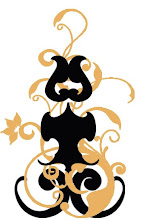In the specific way that you employ these mandalas in your paintings, what do they represent? (I'm ruminating on that "Meditation" one in particular at the moment, but there seems to be a common theme to their use in many of your recent paintings.)DC, for me the mandalas work on a number of levels simultaneously; each of these levels comes into play in each painting, and they are all equally important. In no particular order, they are:
1) A meditation practice, in and of themselves, in the process of drawing them. I am opening myself up to receive guidance about how to work, while working within the same stringent form.
2) A metaphor for an underlying holistic order, independent of space and time--what Bohm calls 'the implicate order'--which determines how the physical universe unfolds. Since mandalas are circular and symmetrical, they work rather like cut-paper snowflakes--one gesture can simultaneously create form in many different physical and temporal locations.
3) Chakras.
4) Celestial bodies.
5) Organic growth patterns.
Sometimes the lines of force both within and without the mandalas represent kinetic trajectories as well--orbits, currents and gravity.
Thus, these paintings can be read simultaneously as landscapes, mindscapes, microscapes, and metascapes.
And it is quite late, and you can perhaps tell that I just got in from Opening Night in Chelsea. The powers of deconstruction are upon me...













